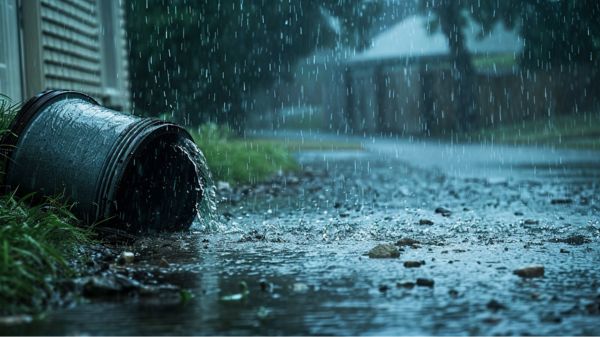Looking for a guide to solve septic tank problems when it rains? You’ve come to right place! You know that in times of heavy rain, septic tanks can face flooding, overloads, and potential backups. This article offers strategies to tackle these challenges effectively.
Understand common issues like flooding and backflow, signs of system overload, and preventive measures such as rainwater diversion and proper maintenance. Learn about solutions like rainwater drainage techniques, aerobic system precautions, and the importance of post-flood care.
Professional tank cleaning and inspections post-flood are emphasized for peak system performance. By implementing these strategies, you can better manage septic tank problems during rainy periods and safeguard your system’s functionality.
Key Takeaways
- Implement rainwater diversion strategies to prevent septic tank flooding.
- Regularly maintain and pump the septic tank for optimal functionality.
- Avoid soil compaction near the drainfield to aid in rainwater drainage.
- Protect aerobic systems from water damage during heavy rain.
- Seek professional septic tank cleaning services for peak performance.
Common Septic Tank Rain Problems
During periods of heavy rainfall, septic tank systems commonly experience flooding and backflow issues, posing significant challenges for homeowners. When heavy rain inundates the soil around a septic system, the excess water can saturate the drain field, leading to a lack of proper drainage and causing backups into the household plumbing.
This overload of water entering the septic tank can overwhelm the system, leading to potential backflow problems and compromising the overall functionality of the septic system. To address these issues, homeowners should consider implementing preventive measures.
Regular inspections to make sure the system is functioning correctly, reducing water usage during heavy rainfall periods, and diverting rainwater away from the septic system can all help mitigate the risk of flooding and backflow problems.
Additionally, for aerobic septic systems with electrical components, protecting these vulnerable parts from water damage during rain events is critical to maintaining the system’s effectiveness. By taking these precautions, homeowners can better safeguard their septic systems against the challenges posed by heavy rainfall.

Signs of Septic Tank Flooding
When encountering septic tank flooding issues, homeowners should be vigilant for specific signs indicating potential system overload during heavy rainfall.
Standing water or puddles around the septic tank area are visible indicators of flooding. Foul odors near the drainfield or septic tank can signal water saturation and potential flooding. Additionally, slow draining sinks, showers, or toilets may suggest a flooded septic system struggling to manage excess water.
Another sign to watch for is lush green grass or unusually healthy vegetation above the drainfield, which can be a result of septic tank flooding. Gurgling sounds in drains or toilets could also point to water backing up due to septic system flooding.
Recognizing these signs promptly can help homeowners address septic tank flooding issues before they escalate, potentially preventing more extensive damage and costly repairs.
Related Post: Identifying and Troubleshooting Septic Tank Problems.
Preventing Septic Tank Overflows
To prevent septic tank overflows, implementing rainwater diversion strategies such as proper drainage systems and backflow prevention devices is essential.
Regular tank maintenance, including timely pumping of excess waste and upgrading to high-efficiency toilets, can greatly reduce the risk of overflows during rainy seasons.
Additionally, maintaining clear vegetation around the drainfield is vital in preventing water stagnation and potential septic tank overflows in wet weather conditions.
Rainwater Diversion Strategies
How can rainwater diversion strategies effectively prevent septic tank overflows and maintain system functionality during heavy rainfall events? Implementing various techniques such as redirecting rain gutters, installing French drain systems, creating sloped surfaces, and utilizing rain gardens can help manage excess rainwater and prevent septic system issues.
Here is a table summarizing these rainwater diversion strategies:
| Rainwater Diversion Strategies | Description |
|---|---|
| Redirect Rain Gutters | Guarantee rain gutters direct water away from the septic system. |
| French Drain System | Install to divert rainwater away from the septic tank and drainfield. |
| Sloped Surface | Create a sloped surface around the septic system to guide rainwater runoff away. |
| Rain Gardens | Implement to absorb excess rainwater before reaching the septic system. |
Regular Tank Maintenance
Implementing a consistent schedule of septic tank maintenance plays a critical role in preventing overflows, particularly during periods of heavy rainfall that can challenge the system’s capacity. Regular septic tank maintenance involves pumping out excess waste to maintain the proper functioning of the sewer system and prevent backups.
Inspections every three years for standard systems and annually for advanced systems help assess the tank’s condition, ensuring it can withstand the increased flow of water during rainy seasons. Professional septic service visits are essential for evaluating the tank’s capacity and readiness for heavy rainfall, helping to avoid potential drainfield issues and overflows.
Rainwater Drainage Solutions
When addressing rainwater drainage issues in septic systems, ensuring a higher elevation in the drainfield is essential to prevent water accumulation and maintain proper drainage.
To enhance rainwater management, utilizing sump pumps with a control panel can effectively regulate water levels in the drainfield, preventing oversaturation and potential system overload.
Additionally, avoiding the passage of heavy vehicles near the drainfield is important to prevent soil compaction, which can impede water infiltration and disrupt drainage.
Ensuring that the soil above the drainfield remains loose is also critical for facilitating water absorption and preventing waterlogging issues.
Regularly trimming vegetation around the drainfield is recommended to prevent water stagnation and minimize the risk of blockages that can hinder proper drainage.
Finally, maintaining well-aerated soil in the drainfield promotes microbial activity, aiding in the decomposition of waste and improving overall drainage efficiency.
Aerobic System Rain Precautions
During heavy rain events, what precautions should be taken to safeguard aerobic septic systems from potential damage?
Aerobic septic systems are equipped with electrical components that are vulnerable to water damage during heavy rain. To prevent harm to these electrical parts, it is essential to shut down the system during flooding. This proactive measure will help avoid costly repairs or replacements due to water infiltration.
Additionally, flooding poses the risk of contaminating the area if the treated wastewater is dispersed on the surface from the aerobic system. Minimizing water usage during flood events is essential to prevent overwhelming the aerobic septic system. Water conservation practices can help alleviate stress on the system and reduce the chances of malfunction.
Ensuring electrical protection by turning off power to the aerobic system during heavy rain will safeguard the components from potential damage, maintaining the system’s functionality and longevity. By implementing these precautions, aerobic septic systems can better withstand adverse weather conditions and operate effectively.
Septic Tank Post-Rain Inspection
After heavy rainfall, conducting a thorough inspection of the septic tank is crucial to assess any potential damage or issues that may have arisen.
Start by checking for signs of flooding, such as water pooling around the tank, which could indicate a problem with the tank’s waterproofing techniques. Look for any erosion or damage to the surrounding area to guarantee structural integrity.
Inspect the septic tank for cracks or leaks that may have developed due to the heavy rainfall, as these could lead to water damage. Additionally, examine the drainfield using appropriate inspection methods to verify that it is not clogged or damaged from excess rainwater.
To prevent future issues, consider implementing water damage prevention strategies, such as improving drainage around the septic system. Remember to turn off power to aerobic treatment units before inspection to avoid any electrical hazards and accurately assess for water damage.
Conducting a detailed post-rain inspection will help identify and address any septic tank issues promptly.
Septic Tank Professional Cleaning
To maintain peak system performance and prevent potential issues, professional septic tank cleaning is essential for removing accumulated sludge and scum efficiently. Certified technicians equipped with specialized tools perform this important task by pumping out waste and thoroughly cleaning the tank.
Regular professional cleaning not only prevents clogs, backups, and system failures during heavy rain events but also extends the lifespan of the septic system and guarantees its proper functionality. It is highly recommended to schedule septic tank cleaning with licensed professionals to avoid potential health hazards and environmental contamination.
In cases of emergencies or when facing wet weather septic care challenges, relying on professional services for rainy day tank solutions is key to keeping the system running smoothly. By entrusting the maintenance of your septic tank to experts, you can rest assured that your system will operate efficiently and effectively, even in adverse weather conditions.
Post-Flood Septic System Care
After a flood event, it is essential to minimize water usage to prevent overloading the septic system.
Conduct a thorough inspection of the septic system for any signs of damage, erosion, or debris that may have accumulated during the flood. Prior to any maintenance or inspection activities, make sure that the power to the septic system is turned off for safety reasons.
Flood Aftermath Precautions
In the aftermath of a flood, taking immediate and systematic precautions is essential to safeguard the integrity and functionality of your septic system.
To prevent soil absorption issues and protect the drain field, minimize water use post-flooding to avoid system saturation and overload. Conduct a thorough inspection for damage and erosion within the septic system, ensuring proper functioning.
Prioritize safety by turning off power before examining the system to mitigate electrical hazards. If hazardous sewage has entered the house during flooding, seek professional assistance for cleaning to prevent health risks. For detailed guidelines on post-flood septic system care, refer to a fact sheet outlining specific steps for restoration and maintenance.
Post-Storm Tank Maintenance
After addressing the aftermath of a flood and ensuring immediate precautions have been taken, the focus shifts to the necessary maintenance steps for post-storm septic tank care. Following a flood, it is essential to minimize water use to prevent system saturation and overload, allowing time for the soil absorption to recover.
Conduct a thorough inspection for damage and erosion, paying close attention to the drain field’s condition. Consider adjusting the pumping frequency to alleviate any excess strain on the system caused by the flood. It is advisable to seek professional assistance for hazardous sewage cleanup inside the house.
Referring to a fact sheet on post-flood septic system care can provide detailed guidelines for maintaining the septic system’s health and functionality.
Frequently Asked Questions
How to Fix a Septic Tank That Backs up When It Rains?
To fix a septic tank that backs up when it rains, address potential issues with the drain field, inspect for root intrusion, and consider adjusting pumping frequency. Seek professional assistance to guarantee proper resolution and prevent further complications.
Why Does My Septic Tank Fill up After Heavy Rain?
Excessive rainfall can inundate the soil around a septic tank, leading to groundwater infiltration and causing the tank to fill up. To mitigate this issue, proper septic tank maintenance, including improved drainage solutions, is essential to prevent overfilling during heavy rain events.
Why Won’t My Septic Tank Toilet Flush When It Rains?
When heavy rain impedes septic tank toilet flushing, consider enhancing drainage solutions, implementing waterproofing techniques, and conducting plumbing maintenance. Drainage improvements can prevent water saturation, while waterproofing protects the system. Regular plumbing upkeep guarantees peak functionality during rainy periods.
How Do You Keep Rainwater Out of Your Septic Tank?
To prevent rainwater infiltration into a septic tank, implement waterproofing solutions such as maintaining a well-graded landscape, installing rainwater diversion systems, and checking the condition of the tank lid regularly. Proper drainage maintenance and planting practices also help mitigate water ingress issues.
Conclusion
To summarize, addressing septic tank problems during rainy weather requires proactive measures to prevent flooding and overflows. Regular inspection, maintenance, and proper drainage solutions can help mitigate the risks associated with heavy rainfall.
It is vital to take necessary precautions to guarantee the functionality and longevity of the septic system, ultimately avoiding costly repairs and environmental damage. Professional cleaning and post-flood care are essential steps in maintaining a healthy septic tank system.





